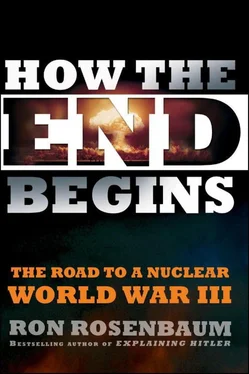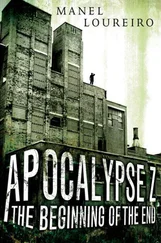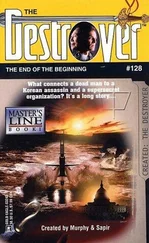He was referring, he told me, to Major Hering and his still unanswered question about how a missileer in his capsule beneath the prairie can know a launch order is legitimate or at least comes from a nominally sane person.
Throughout and after the Cold War STRATCOM managed to keep the issue well hidden under the radar and to suppress the inconvenient truth that in many wartime scenarios a military commander instead of the President or his/her legal successors might have been the source of a lawful-appearing launch order.
So for all the billions the Pentagon has spent promising to upgrade command and control, Blair is saying, we still can’t have complete confidence that a “lawful-appearing” launch order is actually lawful. Now he comes to his most sensational assertion.
The article’s discussion of launch “voting” in which four people in two separate capsules are allegedly required to initiate a missile launch omits the exceptions to this rule. Everything in the nuclear world does not go in pairs, contrary to the article’s characterization. In reality, a single “vote” issued by a single two-person launch crew in a single capsule will do the trick in some circumstances. As many as all fifty missiles in the squadron’s field can be launched this way if one capsule is the sole survivor of an attack, or if other factors cause launch crews in other capsules to take no action to inhibit a single-vote launch. Without straining credulity too much, suffice it to say that a variety of these factors exists, ranging from human error to confusion to negligence to terrorist sabotage. Uncertainty over the validity of a launch order may generate such unusual voting results. “Napping” crew members with alarm circuit breakers pulled to enhance their rest could also generate such strange voting scenarios. By the way, it’s not rare for the missileer keeping watch while the other naps to fall asleep too. The prudence of allowing napping at all escapes me, since it technically violates the fundamental safety canon of nuclear weapons operations—the 2-person rule that normally requires two competent and watchful individuals working in tandem in sensitive positions. Tolerating an exception for duty launch crews for economic reasons is dubious judgment.
Who knew that napping had the potential to be so apocalyptically significant?
But Blair’s urgent point was that a single canny missileer could, for whatever mad reason, launch fifty missiles on his own given the right circumstances. Unlikely yes. Low probability, but apocalyptic impact.
As it turns out, the flaw in the two-man capsule crew was not the only command and control problem left unresolved at the end of the Cold War. The system’s entire architecture was vulnerable. Blair was the first former Pentagon employee to point out publicly in his 1985 testimony to the Government Operations Subcommittee [167]that EMPs—or electromagnetic pulses [168]—made the whole nuclear command and control system vulnerable: he was aware of top secret studies that modeled the effect of high-altitude nuclear blasts, or super-powerful laserlike pulses of electromagnetic radiation on the electronics that linked the nation’s entire command and control system together. The gloomy conclusion of these studies was that while certainty was impossible until the horrific moment, it looked like a suborbital nuclear air blast could zap our system into uselessness. We wouldn’t know what was about to hit us, nor would we be able to hit back. The enemy would not have to bother to cut off the head of our top leaders with a nuclear strike; it would just have to, in effect, cut off their hands so they could not push the button. Or cut off the button from the rest of the system.
“I was there in 1971 when Omaha had just discovered the devastating effects of electromagnetic pulse, EMP,” he said. He described the drama of the realization that an EMP from an airborne nuclear blast could fry ground-based electronic systems, making them unworkable.
The Air Force sought to devise workarounds once the magnitude of the EMP threat to controlling nukes pre- and post-attack began to emerge. “They did a quick-and-dirty assessment of our last gasp at command and control, with the Looking Glass [plane that could relay signals to missiles underground] at the heart of it, “Blair told me.” And the conclusion basically is that the whole command and control system could be neutralized. We could be unable to retaliate. That our deterrent threat was hollow. And a hollow deterrent threat virtually invited a surprise nuclear attack.”
“This was 1971 when it was discovered?”
“Nineteen seventy-one when it was discovered. This was highly secret at the time because we were trying to figure out workarounds for the planes, ways to protect it on an emergency basis.”
“Workarounds for the Looking Glass plane?”
“That plane and all the other planes in this fleet,” Blair said. “There were planes that connected all the way from the East Coast, which was where the president’s plane—Kneecap—the Doomsday Plane, was—”
“Kneecap?”
“Spelled NEACP, for the National Emergency Airborne Command Post, and it was to be connected to other planes in this chain, the system is called PACCS, Post-Attack Command and Control System.” [169]
The workaround system seemed remarkably primitive: “A series of the planes were tied together electronically, line of sight. Strung together they would relay messages from the president who might be orbiting somewhere over the East Coast in his plane, all the way out to Looking Glass, beyond Looking Glass then to these planes that can fire these missiles from the air—the ALCC, the Airborne Launch Control Centers. So we were sort of in a panic at the time because they could all be rendered mute by an EMP.”
“Did we know if the Russians knew they could do this?”
“I wasn’t privy to the intelligence of what the Russians knew; I only knew what we believed our vulnerabilities were. And we had to assume there’d be at least a random good luck shot by the Russians, a cheap shot, just in case. Because they [the Russians] knew about electromagnetic pulse. They wouldn’t know about our specific vulnerabilities, more generic kind of vulnerabilities. They would know that EMP would create huge electronic current on the skin of an aircraft and that it would sort of flip fuses and burn out circuits and all that, but they couldn’t know precisely the degree of damage.”
And now?
“We still don’t know because it took decades for us to begin to really learn scientifically what the dangers were. We had to create this huge trestle EMP simulator to put things in and zap them and sort of measure the outputs.”
He is describing a test system that subjects potentially vulnerable electronic elements of our C3 system to simulated electromagnetic pulse radiation to see whether they still function.
“So we lived in the 1970s in a state of acute uncertainty about the viability of our nuclear deterrent force if it’s used in a second strike mode,” Blair says.
Acute uncertainty? Not what we were told. We were told that Mutually Assured Destruction made us safe; it was stable. If we believed our deterrent was sketchy—and we believed that they believed we believed it was—then we were all in trouble.
We still are in trouble. Listening to Blair is like having gone through the Looking-Glass and coming back—although not all the way back. He is still deeply enmeshed in the world he left behind and the ways in which he believes it has become even more dangerous.
In fact, I came to see that Blair thought my concern about the existence of the dead hand PERIMETR system in Russia was misplaced. It was something to be thankful for.
Why? By giving the Russian chain of command confidence that they could execute retaliation even after a decapitating strike. If we are aware that they can carry out a retaliatory strike no matter what, then we will be less likely to strike first. And the Russians themselves would be less likely to fire first and ask questions later under a use it or lose it scenario, if they knew they had a backup automated system. PERIMETR meant, to the Kremlin, they wouldn’t “lose it,” thus would be less likely to “use it,” which would make their finger on the nuclear trigger less quick to fire in order to keep their deterrent from being neutralized.
Читать дальше











